The fastest way to get abs is by combining fat loss through a calorie-controlled diet with targeted core training, strength workouts, and healthy lifestyle habits. Without reducing body fat, no amount of ab exercises will reveal your six-pack.
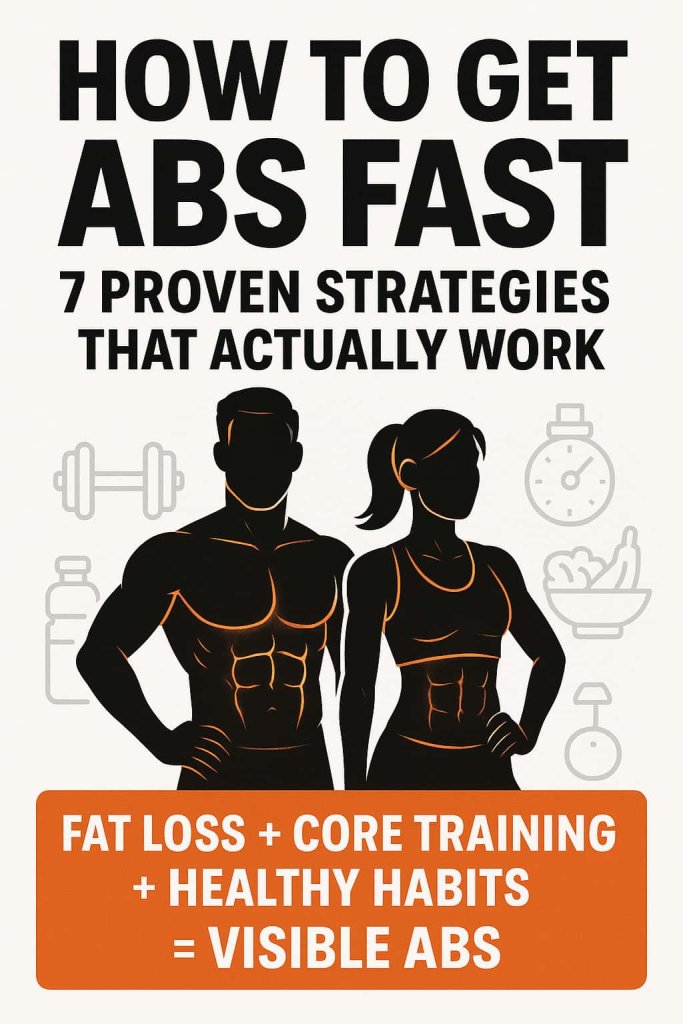
This article goes beyond generic advice — you’ll get evidence-backed strategies, real-world training recommendations, and nutrition tips you can implement today. Whether you’re aiming for shredded summer abs or simply want a stronger, more defined core, these steps work when followed consistently.
1. Focus on Fat Loss First — It’s 80% of the Equation

Visible abs appear when your body fat reaches a lean range. While exact numbers vary by genetics and body type, a general guideline is:
- Men: Around 10–15% body fat for clear ab definition
- Women: Around 16–22% body fat for visible tone
Even the strongest core muscles will remain hidden under excess fat, so reducing overall body fat is the first priority.
How to create a calorie deficit:
- Track calories using an app like MyFitnessPal or Cronometer.
- Reduce daily intake by 300–500 calories below maintenance.
- Increase activity levels — more steps, workouts, and active hobbies.
Why slow fat loss is better:
Rapid weight loss often causes muscle breakdown and metabolic slowdown. A steady pace (0.5–1 lb per week) keeps muscle mass intact, making your abs look sharper when fat comes off.
Pro Tip: Pair strength training with a small calorie deficit. This maintains lean muscle and improves metabolic rate — a win-win for fat loss.
2. Eat a High-Protein, Whole-Food Diet
Nutrition is the most controllable factor in your ab journey. The quality and composition of your meals directly affect fat loss and muscle retention.
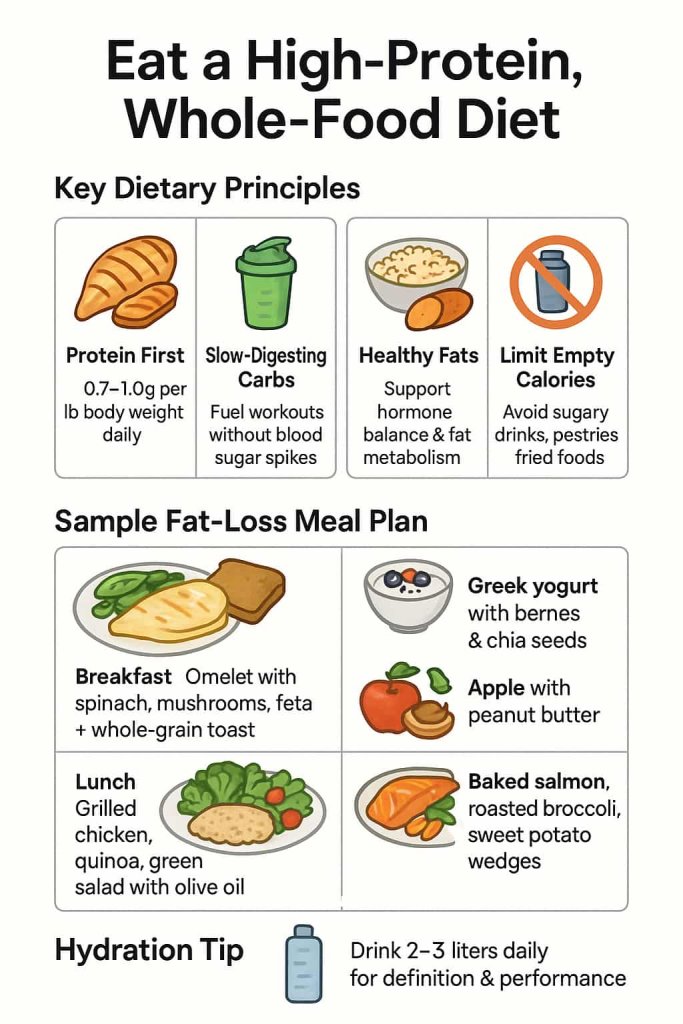
Key dietary principles:
- Protein first: Aim for 0.7–1.0g per pound of body weight daily. This boosts satiety and supports muscle repair.
- Choose slow-digesting carbs: Oats, quinoa, brown rice, and sweet potatoes fuel workouts without blood sugar spikes.
- Don’t fear healthy fats: Avocado, olive oil, and fatty fish support hormone balance, which aids fat metabolism.
- Minimize empty calories: Sugary drinks, pastries, and fried foods slow fat loss.
Sample fat-loss meal plan:
- Breakfast: 3-egg omelet with spinach, mushrooms, and feta + whole-grain toast.
- Snack: Greek yogurt with berries and chia seeds.
- Lunch: Grilled chicken breast, quinoa, and mixed green salad with olive oil dressing.
- Snack: Apple slices with natural peanut butter.
- Dinner: Baked salmon with roasted broccoli and sweet potato wedges.
Hydration Tip: Drink 2–3 liters of water daily. Dehydration can make your abs look less defined and reduce training performance.
3. Train the Entire Core, Not Just the “Six-Pack” Muscle
The rectus abdominis (six-pack muscle) is just one part of the core. Your transverse abdominis, obliques, lower back, and deep stabilizers are equally important.
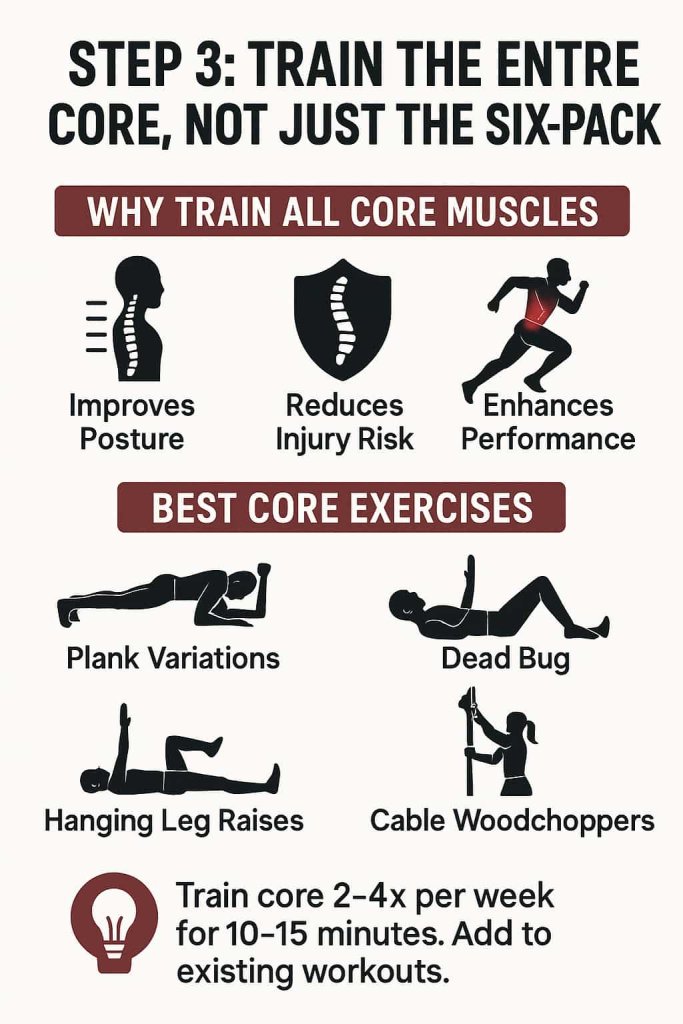
Why training all core muscles matters:
- Improves posture and spinal alignment.
- Reduces injury risk during heavy lifts.
- Enhances performance in sports and daily activities.
Best exercises for a complete core:
- Plank variations: Standard plank, side plank, and RKC plank for endurance and stability.
- Dead bug: Strengthens deep core muscles while teaching spinal control.
- Hanging leg raises: Targets lower abs dynamically.
- Cable woodchoppers: Improves rotational power for sports and functional strength.
- Bird dog: Builds anti-rotation and anti-extension strength.
Pro Tip: Train your core 2–4 times per week for 10–15 minutes per session. Pair core training with your regular workouts to avoid skipping it.
4. Use Compound Strength Training to Burn Fat and Build Muscle
Compound lifts engage multiple muscle groups — including your core — and burn more calories than isolation exercises.
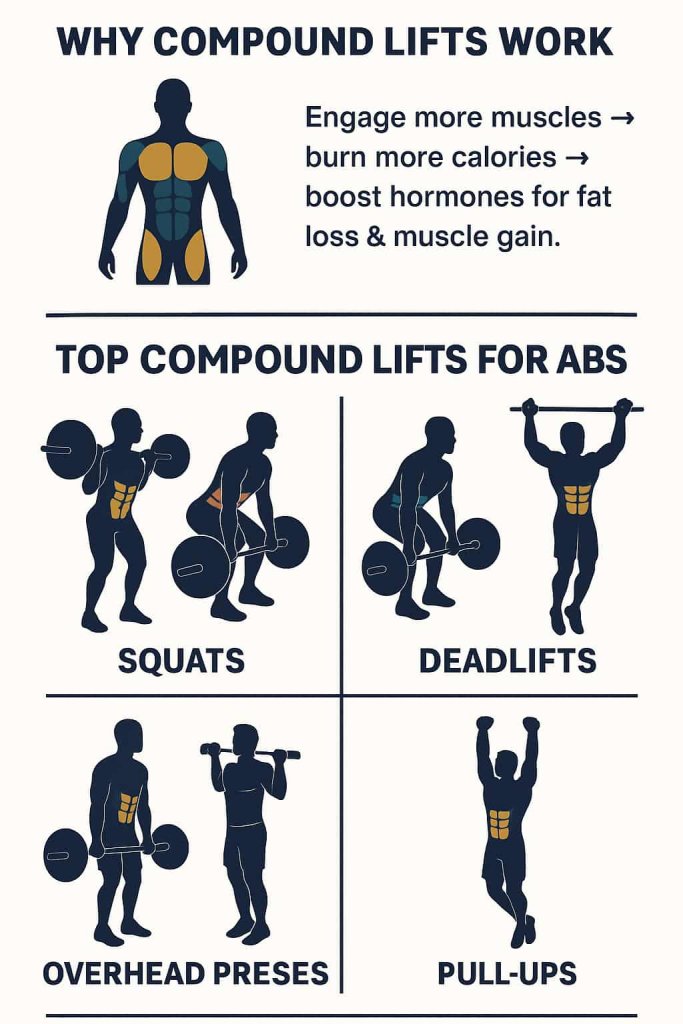
Top compound lifts for ab development:
- Squats: Force core stabilization under load.
- Deadlifts: Strengthen lower back, obliques, and deep core muscles.
- Overhead presses: Demand total core engagement to keep the spine stable.
- Pull-ups: Challenge your abs through body stabilization.
Science says: A study in the Journal of Strength and Conditioning Research found that compound lifts not only burn more calories but also produce higher hormonal responses, which supports fat loss and muscle gain.
Pro Tip: Heavy lifting + proper core activation turns every workout into an ab workout without adding extra hours in the gym.
5. Add High-Intensity Interval Training (HIIT) to Your Cardio
HIIT is more time-efficient and can burn more fat than steady-state cardio. It keeps your metabolism elevated for hours after the workout, a phenomenon called EPOC (Excess Post-Exercise Oxygen Consumption).
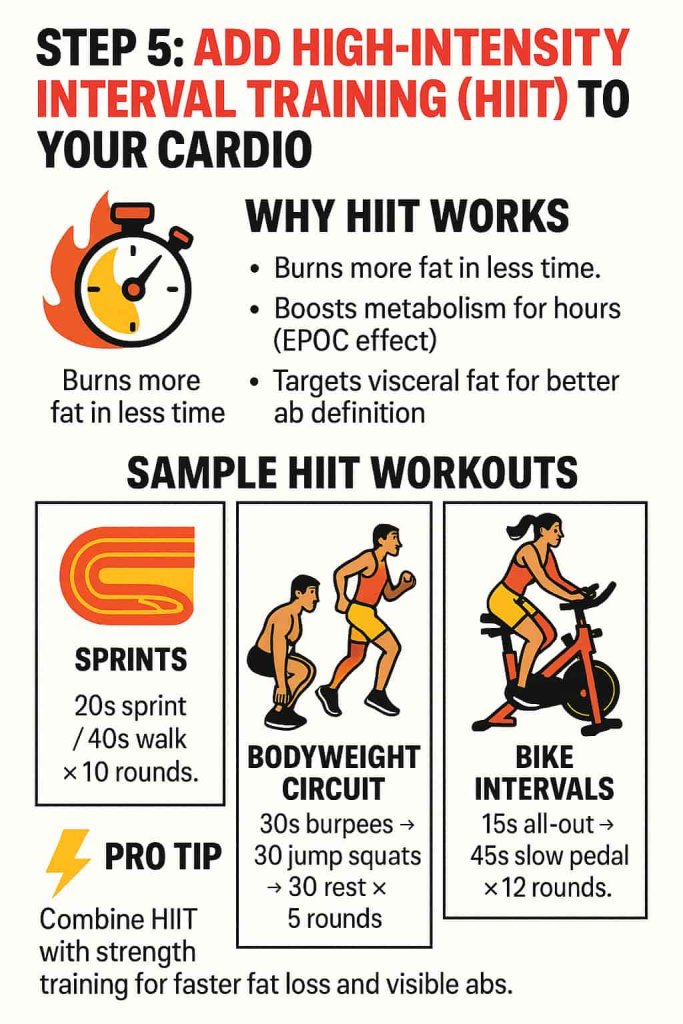
Sample HIIT workouts for fat loss:
- Sprints: 20 seconds sprint / 40 seconds walk × 10 rounds.
- Bodyweight circuit: 30s burpees → 30s jump squats → 30s rest × 5 rounds.
- Bike intervals: 15s all-out → 45s slow pedal × 12 rounds.
Why HIIT works for abs: HIIT reduces total body fat, including visceral fat that hides abdominal muscles. This not only improves appearance but also benefits long-term health.
6. Prioritize Sleep, Recovery, and Stress Management
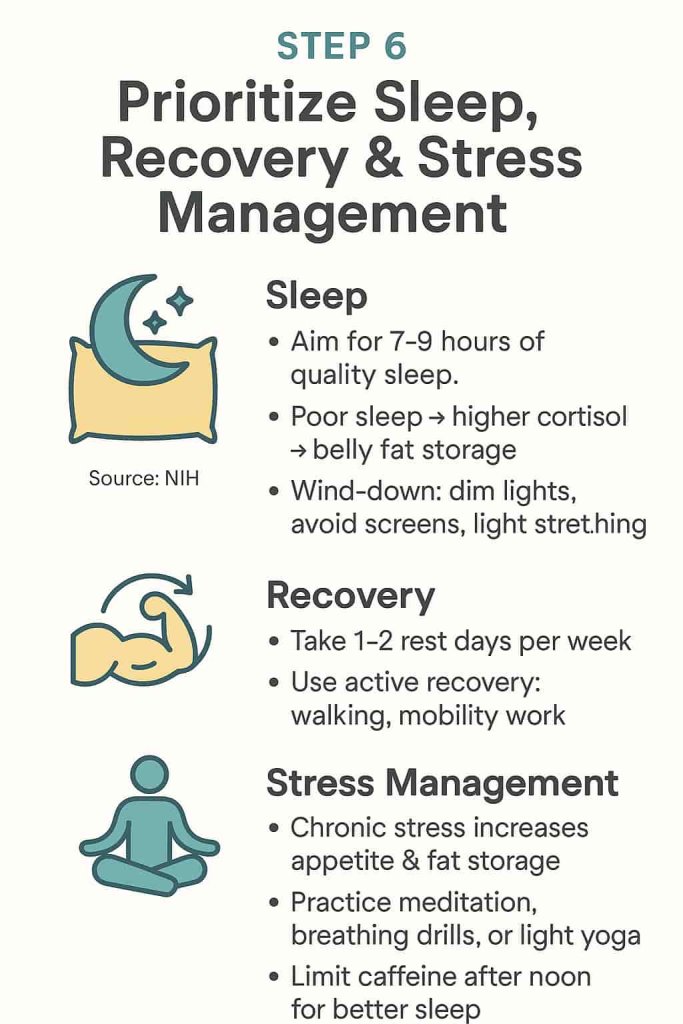
Sleep:
- Aim for 7–9 hours. Poor sleep raises cortisol, a stress hormone linked to belly fat storage (NIH).
- Use a wind-down routine — dim lights, avoid screens, stretch lightly before bed.
Recovery:
- Take 1–2 rest days per week.
- Include active recovery (walking, mobility work) to boost blood flow.
Stress management:
Chronic stress increases appetite and fat storage.
- Try meditation, breathing drills, or light yoga.
- Reduce caffeine after noon to improve sleep quality.
7. Stay Consistent and Track Progress
Consistency matters more than perfection. Many people quit after a few weeks because results seem slow — but body recomposition takes time.
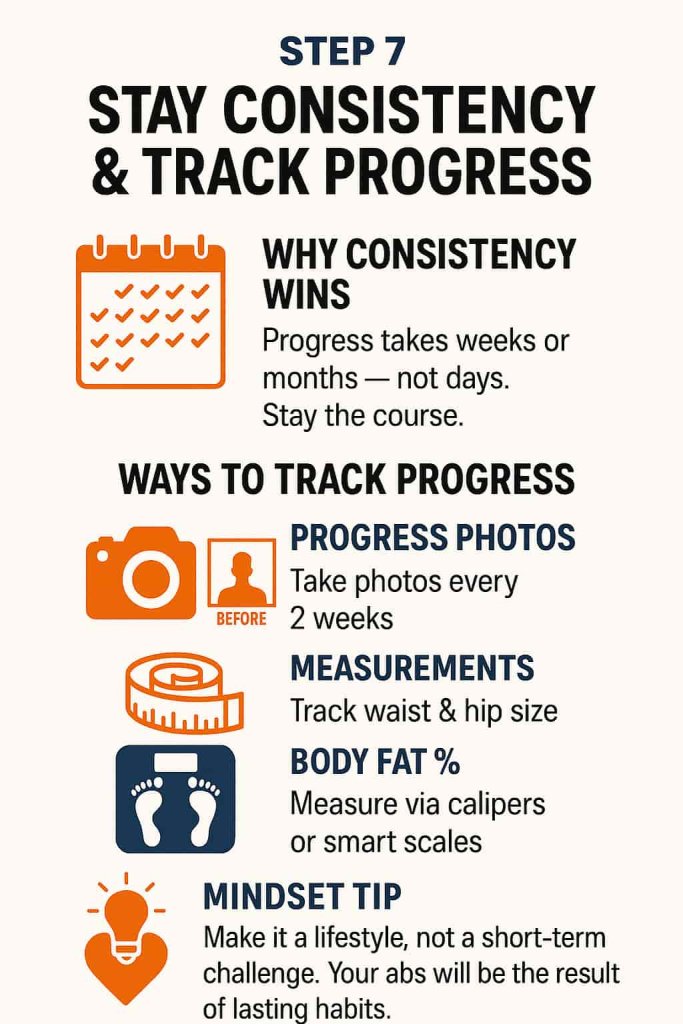
Ways to track progress:
- Progress photos every 2 weeks.
- Tape measurements of waist and hips.
- Body fat percentage via calipers or smart scales.
Mindset Tip: Think of your ab journey as a lifestyle change, not a short-term challenge. You’ll maintain your results long after achieving them.
FAQ – How to Get Abs Fast
- Q1: Can I get abs without losing weight?
Yes — if your body fat is already low, building muscle will make your abs pop without significant weight loss. - Q2: Are crunches effective?
Yes, but they should be part of a broader program that includes stability and rotational core exercises. - Q3: How often should I train abs?
2–4 times per week is optimal for most people. - Q4: Should women train abs differently than men?
Not really — the exercises are the same, but body fat goals differ slightly for visual definition. - Q5: Do waist trainers work?
They may give a temporary slimmer look but won’t burn fat or build muscle. - Q6: What’s the fastest safe timeline to get abs?
Anywhere from 8–16 weeks, depending on your starting point. - Q7: Can I spot-reduce belly fat?
No — fat loss happens systemically. You can’t choose where to lose fat first.
Conclusion
Getting abs fast is about combining steady fat loss, smart nutrition, full-core training, and consistent healthy habits. Skip fad diets and “magic” ab gadgets — the proven approach is sustainable, effective, and backed by science.
Start today by dialing in your diet, committing to regular strength and core training, and giving your body the rest it needs. With discipline and patience, your six-pack will be the natural result of your lifestyle.
